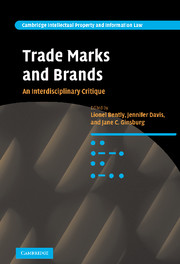Book contents
- Frontmatter
- Contents
- List of figures and tables
- Notes on the contributors
- Editors' preface
- Table of cases
- Table of statutes
- Part I Legal and economic history
- Part II Current positive law in the EU and the USA
- Part III Linguistics
- Part IV Marketing
- Part V Sociology
- Part VI Law and Economics
- Part VII Philosophy
- Part VIII Anthropology
- Part IX Geography
- 17 Geographical Indications: not all ‘champagne and roses’
- 18 (Re)Locating Geographical Indications: a response to Bronwyn Parry
- Bibliography
- Index
- Titles in the series
18 - (Re)Locating Geographical Indications: a response to Bronwyn Parry
Published online by Cambridge University Press: 13 April 2010
- Frontmatter
- Contents
- List of figures and tables
- Notes on the contributors
- Editors' preface
- Table of cases
- Table of statutes
- Part I Legal and economic history
- Part II Current positive law in the EU and the USA
- Part III Linguistics
- Part IV Marketing
- Part V Sociology
- Part VI Law and Economics
- Part VII Philosophy
- Part VIII Anthropology
- Part IX Geography
- 17 Geographical Indications: not all ‘champagne and roses’
- 18 (Re)Locating Geographical Indications: a response to Bronwyn Parry
- Bibliography
- Index
- Titles in the series
Summary
Introduction
A particular vision of geographical place has shaped much of the discourse and international legal architecture for the protection of Geographical Indications (GIs). Dr Bronwyn Parry incisively demonstrates that this view is dangerously myopic as it makes several unsustainable assumptions. If the function of GIs is to guarantee the quality and authenticity of regional products such as Champagne, these desirable features rest on static, deterministic notions of place. Contemporary scholarship reveals place to be far more porous and dynamic, thereby throwing into doubt the very ontological foundations of GI protection. While acknowledging the value of this appraisal, this response frames it within historical legal and institutional responses, thereby drawing limits around its conclusions. The critique is potent but does not necessarily signal the end of GIs. Instead, it helps to reposition the justification for this regime, placing it on a more durable foundation.
Through a formal challenge to the central premise of GI protection – that place can act as a guarantor for quality and authenticity – Dr Parry is asking whether GIs are ‘fit for purpose’. Through the lens of a richer account of place, she interrogates this premise by asking: (i) what is the work GIs are being asked to do?; (ii) how they do this work; and (iii) whether more suitable alternatives exist. As a response to this, this response begins by both expanding the critique and qualifying it.
- Type
- Chapter
- Information
- Trade Marks and BrandsAn Interdisciplinary Critique, pp. 381 - 397Publisher: Cambridge University PressPrint publication year: 2008
- 3
- Cited by



